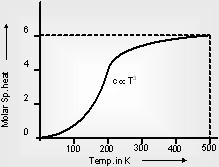Specific Heat Capacity Of Gases
Specific heat of a gas is numerically equal to the amount of heat necessary to raise the temperature of unit mass of gas by 1°C. In order to raise the temperature of unit mass of a gas through 1°C more heat will be required if the gas was kept at constant pressure than when it is at constant volume.
(i) Molar Specific heat capacity at constant Volume: The amount of heat required to raise the temperature of 1 mole of gas by 1 °C at constant volume is called the molar specific heat and it is represented by Cv.
Cv = (ΔQ/mΔt)v = constant
By first law of thermodynamics ΔQ = ΔU + W
But W = 0 for isochoric process, then ΔQ = ΔU
by definition of specific heat ΔQ = nCvΔT
Where CV is the specific heat (for 1 mole of gas), then ΔU = nCvΔT
The relation ΔU = nCvΔT, is used to find the change in internal energy of the system and is valid for any process where a temperature change has taken place.
Consider two isotherms on the P-V diagram:
Process 1 –> 2 represents an isochoric process
Process 1 –> 3 represents an isobaric process
|  |
In both processes the temperature has changes from T1 to T2 as 2 and 3 lie on the same isotherm. Thus change in internal energ
U1–>2 = U1–>3 = nCvΔT
(ii) Molar Specific heat capacity at constant Pressure: The amount of heat required to raise the temperature of 1 mol of gas by 1°C keeping its pressure constant, is called molar specific heat at constant pressure and it is represented by Cp,
Cp = (ΔQ/mΔT)P = constant
(iii) Relation between Cp and Cv: For an isobaric process by definition
From first law ΔQ = ΔU + W
=> nCPΔT = nCVΔT + W [∴ ΔU = nCVΔT for any process]
For isobaric process
W = PΔV = nRΔT nCPΔT = nCVΔT + nRΔT
=> CP = CV + R or CP - CV = R (Meyer’s relation)
(iv) Relation between specific heat (CP and CV) and degrees of freedom: If f is the number of degree of freedom of a gas molecule then the internal energy of n moles of that gas is given by
U = f × 1/2 nRT (from law of equipartition of energy)
(∴ U = f/2 kT = f/2 R/N T (for n moles) = nN × f/2 R/N T = n f/2 RT)
=> dU = f × 1/2 nRdT
Also dU = nCVdT,
So, nCVdT = f × 1/2 nRdTf/2 R
but CP = CV + R
∴ CP = (f/2 f/2 + 1)R. This is the relation between specific heat ratio and degree of freedom.
(v) Adiabatic Expansion of an Ideal gas: As defined earlier in adiabatic process ΔQ = 0
For a system containing an ideal gas adiabatic process can happen in two ways
(i) if the system boundary is adiabatic
(ii) if the system boundary is diathermic but the process takes place so fast that their is no time for the transfer of the heat. For example, Propagation of sound in air.
For an adiabatic process as shall be proved
PV? = a constant, here g = CP/ CV. ? is known as adiabatic constant
Since PV = nRT for an ideal gas
P = nRT/V so,
(nRT/V)Vg = Constant ∴ TVg–1 = a constant
Proof: Let n moles of an ideal gas expand adiabatically by a small amount ΔV.
By first law ΔQ = ΔU + PΔV
As ΔQ = 0 we have ΔU = –PΔV
But U = nCvΔT
So, nΔT = –(P/Cv)ΔV …(i)
From the ideal gas law (after differentiating) , PΔV = VΔP = nRΔT
Replacing R by its equal, CP - CV leads to this, nΔT = PΔV + VΔP/Cp – Cv …(ii)
equating (1) and (2) with a little algebra leads to
ΔP/P + (Cp/Cv) ΔV/V = 0 Cp/Cv = g
and integrating we have, ln P + g In V = a constant,
or PVg = a constant, hence proved.
Again g = Cp/Cv = Cv + R/CV = 1 + R/Cv = 1 + R/(1/2 fR) = 1 + 2/f
(vi) Work done in an adiabatic process (P1V1T1) to (P2V2T2)
For adiabatic process, W = –ΔU = –n CvΔT
From ideal gas equation P1V1 – P2V2 = nR (T1 – T2) = – nRT
W = Cv(P1V1 – P2V2)/R(P1V1 – P2V2)/?–1 = nR(T1 – T2)/–1
(vii) The table shows the values of f, Cv, Cp and g for different gasses:
Nature of gas
|
Degree of freedom
f = (T+R+V)
|
Cv
|
Cp
|
g
|
Monatomic
|
3+0+0 = 3
|
3
|
5
| 5/3 |
Diatomic
|
3+2+0 = 5
|
5
|
7
| 7/5 |
Polyatomic (linear)
|
3+2+0 = 5
|
5
|
7
| 7/5 |
Polyatomic
(non-linear)
|
3+2+1 = 6
|
3R
|
4R
| 4/3 |
Note: At room temperature the energy associated with vibrational motion is negligible in comparison to translational and rotational KE.
Expressions For ΔU, W, And ΔQ For Different Process
Processes
|
Relation between thermodynamic variables
|
Work Done (W)
|
Heat Exchange (ΔQ)
|
Isothermal Process
(T constant)
|
P∝1/V
|
W = 2.303 nRT log10 (V2/V1)
|
ΔQ = 2.303 nRT
log10(V2/V1)
|
Adiabatic Process
(No heat exchange)
|
PVg = constant
|
W = (P1V1 – P2V2)/(g–1) = nR(T1– T2)/(g-1)
|
ΔQ = 0
|
Isochoric Process
(V = constant)
|
P ∝T
|
W = 0
|
ΔQ = n CV ΔT*
(Use definition of Cv)
|
Isobaric Process
(P = Constant)
|
V ∝T
|
W = P Δ V = P(V2 –V2)
W = nR (T2 –T1)
|
ΔQ = n CP ΔT*
(Use definition of Cp)
|
